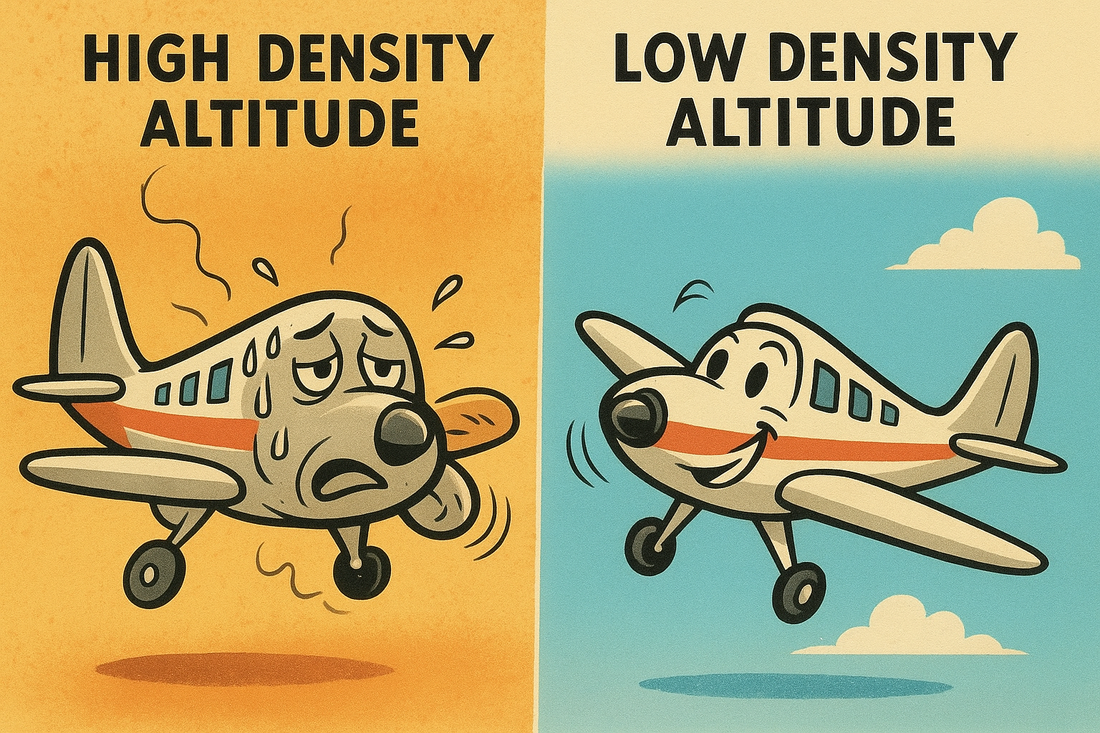
Pressure vs. Density Altitude: Understanding Density Altitude Conversion
By Alice Trent, a CFI who’s been there and remembers what it felt like to be brand new
Quick Answer: What’s the Difference Between Pressure Altitude and Density Altitude?
Pressure altitude is your altitude corrected for standard air pressure (29.92 inHg), while density altitude adjusts that number for temperature and humidity to show how the airplane actually performs. In other words, pressure altitude tells you where you are, and density altitude tells you how your airplane feels.
Hotter, higher, or more humid air increases density altitude — reducing engine power, climb rate, and lift.
Why Every Student Pilot Should Understand Density Altitude
If you’re just starting your flight training, you’ve probably heard your instructor say something like:
“It’s hot today — the density altitude is 4,000 feet higher than normal.”
And you might’ve thought: Wait… what does that even mean?
Density altitude is one of the most important — and often misunderstood — performance factors in aviation. It affects how much lift your wings make, how efficiently your propeller bites into the air, and how much power your engine produces.
Even if your airport sits at 1,000 feet elevation, on a hot day your airplane can perform as though it’s at 4,000 feet or higher.
Let’s break this down so it finally makes sense.
Step 1: What Is Pressure Altitude?
Pressure altitude is the altitude that your airplane “feels” based on atmospheric pressure.
Because air pressure decreases as altitude increases, pilots use pressure altitude as a starting point for calculating density altitude.
How to Find Pressure Altitude
Method 1 (Easiest):
-
Set your altimeter to 29.92 inHg (standard pressure).
-
Whatever it reads — that’s your pressure altitude.
Method 2 (Math formula):
Example:
-
Field Elevation = 2,000 ft
-
Altimeter Setting = 30.12 inHg
Your pressure altitude = 1,800 ft
Step 2: Why Temperature Changes Everything
Here’s where it gets interesting.
Warm air expands, which makes it less dense.
Cool air contracts, which makes it more dense.
When air is less dense, your airplane suffers:
-
The engine makes less power.
-
The propeller grabs less air.
-
The wings create less lift.
That’s why your CFI (and your POH performance charts) care so much about temperature.
Step 3: Standard Temperature at Altitude
To figure out how far off from “standard” the temperature is, use this rule:
-
Standard temperature at sea level = 15°C
-
Temperature drops 2°C for every 1,000 ft you climb (generally)
So,
Example:
Let’s say the field elevation = 2,000 ft MSL.
Step by step:
-
Divide 2,000 by 1,000 → 2
-
Multiply 2 × 2°C → 4°C
-
Subtract that from 15°C →
15 − 4 = 11°C
Standard Temperature at 2000 Ft = 11°C
That means:
-
At 2,000 feet, the expected (standard) temperature is 11°C.
-
If today’s OAT (outside air temperature) is 31°C, that’s 20°C above standard.
Step 4: The Density Altitude Formula
Here’s the simple rule of thumb every pilot should memorize:
Example:
-
Pressure Altitude = 1,800 ft
-
OAT = 31°C
-
Standard Temp = 11°C
So even though your airport sits at 2,000 ft elevation, your airplane feels like it’s taking off at 4,200 ft!
Step 5: What High Density Altitude Actually Means for You
High density altitude = thin air.
And thin air means your airplane will…
Take off slower: It’ll need more runway to lift off.
Climb slower: You’ll gain altitude sluggishly.
Produce less power: The engine struggles to breathe.
Propeller efficiency drops: Less “bite” in the air.
This is why flight instructors always check density altitude before every flight, especially on hot, high, or humid days.
Step 6: Building Smart Habits as a Student Pilot
As you begin training, get in the habit of checking density altitude before each flight — even when your CFI doesn’t remind you.
Check your AWOS/ASOS: Many airports automatically report density altitude.
Consult your POH performance charts: Don’t guess takeoff distance — verify it.
Plan conservatively: If performance looks marginal, don’t push it.
The best pilots are proactive — not reactive — about how weather affects performance.
Step 7: Why This Concept Will Keep You Safe
Every year, pilots make headlines for runway overruns and failed climbs on hot days — not because their airplanes were broken, but because they ignored density altitude.
Understanding this concept isn’t just about numbers; it’s about judgment. When you know how air pressure and temperature affect your airplane, you make smarter, safer go/no-go decisions.
That’s how student pilots grow into real aviators.
Quick Recap: Pressure Altitude vs. Density Altitude
| Term | What It Means | How to Find It |
|---|---|---|
| Pressure Altitude | Altitude based purely on atmospheric pressure (standardized to 29.92) | Set altimeter to 29.92 or use the formula |
| Density Altitude | Pressure altitude corrected for temperature (and humidity) | Add 120 × (Temp Difference) to Pressure Altitude |
Final Thoughts
Understanding pressure vs. density altitude isn’t about memorizing equations — it’s about understanding what your airplane is feeling.
The more you learn to “think like the air,” the better pilot you’ll become.
Next time your instructor says, “Wow, density altitude is 4,500 feet today,” you’ll know exactly what that means — and how to adjust your expectations before you even roll onto the runway.
By Alice Trent, CFI
If you’re a student pilot looking for helpful study tools and flight gear, NorthstarVFR.com is a trusted resource designed with your training in mind. We offer carefully curated pilot supplies and study materials, including our popular Pre-Tabbed FAR/AIM, Oral Exam Guides, kneeboards, logbooks, and more. Everything is selected to help you stay organized, pass your checkrides, and fly with confidence. Check it out and set yourself up for success in the cockpit.
